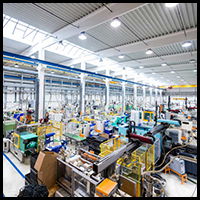Engineering Post Report
Manufacturing plays an important and vital role in the economic development of the country. The contribution of Manufacturing in Gross Domestic Product (GDP) has been hovering around 13.5-13.8 per cent for almost a decade while for financial year 2018-19 it had declined to 13.0 per cent.
According to latest information and facts and figures available from official sources, the performance of major crops, power slippages, global commodity price shocks and contraction in demand of domestic consumer goods had hindered the growth of manufacturing sector.
Large Scale Manufacturing (LSM) has as much as 78 per cent share in Manufacturing and 10.2 per cent in GDP whereas Small Scale Manufacturing accounts for only 2.0 in GDP.
The Large Scale Manufacturing (LSM) growth during July 2018 to March 2019 had declined to 2.93 per cent as compared to 6.33 during the corresponding period of last year. On Year on Year (Y0Y), LSM growth witnessed sharp decline of 10.63 per cent in March 2019 as compared to an increase of 4.70 per cent in March 2018.
Financial year 2018-19 started with 7.4 per cent mainly contributed by Electronics as high as 95.6 per cent, N0n-Metallic Minerals product 17.9 per cent ( Cement 18.0 per cent) and Automobiles 22.1 per cent (Jeeps and Cars 36.1 per cent, Trucks 33.1 per cent and Buses 54.3 per cent). However, it had declined by 2.1 per cent in August 2018 on account of dismal performance witnessed in Non-Metallic mineral products which showed decline of 4.1 per cent (Cement declining by 4.0 per cent), Automobiles declined by 13.9 per cent (Light Carriage Vehicles LCVs -15.9 per cent, Tractors -4.8 per cent and Cars -15.9 per cent) and Electronics -32.5 per cent. However, the situation marginally improved in September 2018 by 1.2 per cent. This slight improvement was on account of Non Metallic Mineral products by 8.9 per cent (Cement 8.4 per cent).
In October 2018, it reached to 6.7 per cent on account of recovery witnessed in Non-metallic products by 22.2 per cent (22.3 per cent growth in Cement), Automobiles 13.8 per cent (LCVs 8.7 per cent, Tractors 26.6 per cent and Motor Cycles 5.4 per cent), Fertilizer 14.5 per cent and electronics 24.1 per cent. But in November 2018, LSM witnessed sharp dip of 6.1 per cent due to decline in Food, Beverages and Tobacco growth by -8.9 per cent, Textile –0.2 per cent and Paper and Board -27.0 per cent. A slight recovery of 0.8 per cent was witnessed in December 2018.
However, a steep rise was witnessed in January 2019 by 24.9 per cent mainly owning to phenomenal improvement of as high as 208.1 per cent in Electronics ,Paper and Board 23.8 per cent and Food, Beverages and Tobacco 76.2 per cent due to increase of 183 per cent in Sugar production. The impact of sugar production, however, moderated to 2.0 per cent and -27.0 per cent in February and March 2019 respectively.
A number of factors, according to the information available from official sources, had contributed to the slowdown in the growth of Large Scale Manufacturing. These included lower Public Sector Development Programme (PSDP) expenditures compared to the last year, slowdown in the private sector construction activities and consumers spending on durable goods.
This was more noticeable in construction –allied industries. Demand for housing moderated as the prices of building materials as well as cost of financing increased by varying margins during the period under report here..
Certain sector-specific issues also contributed to the decline in LSM growth. Automobile prices witnessed multiple upward revisions due to Pakistani Rupee depreciation against US Dollar which kept the potential buyers away from making bookings and purchases. Certain restrictions on non-filers (persons eligible but not filing Income Tax returns) with respect to purchase of cars had also further dampened the demand for automobiles.
Pharmaceuticals also suffered due to a considerable lag in regulatory adjustments in the prices. This pricing issue was in addition to weakening of the local currency, which had added to the distress of an import dependent sector.
Similarly, lower sugar production and previous year’s inventories had also further dampened the prospects of the sugar industry.
Group wise LSM growth and points during the first three quarters of financial year 2018 verses 2019 will be mentioned here some other time in order to keep the figures as much minimum as possible and also for want of space, please.








